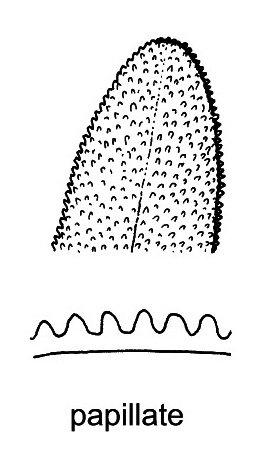|
|
 |
Key to FrangulaView taxon page for Frangula
(For a list of species in Frangula, use the above link.) Jepson Manual glossary definitions can be seen by moving your cursor over words underlined with dots. 1. Leaves deciduous, blades thin 2. Fruit 3-stoned; leaf  Organ arising from a stem, generally composed of a stalk (petiole) and a flat, expanded, green, photosynthetic area (blade); distinguished from a leaflet by the presence in its axil of a bud, branch, thorn, or flower; sometimes with lateral, basal appendages (stipules); either simple (toothed, lobed, or dissected but not divided into leaflets) or compound (divided into leaflets). blade  Expanded portion of a leaf, petal, or other structure, generally flat but sometimes rolled, cylindric, wavy, or cupped. (50)80–150 mm ..... F. purshiana 3. Leaf blade blue- or green-gray, ± glaucous when fresh, papillate  Pertaining to a surface (e.g., of a leaf, stigma, fruit) bearing small, rounded or conic protuberances (papillae). , densely hairy or adaxially velvety, light green, abaxially sparsely to densely hairy ..... subsp. ultramafica (2) 3' Leaf blade green, not papillate, glabrous to sparsely hairy 4' Leaf base rounded or cordate  Heart-shaped; often pertaining to a leaf in which the blade base on both sides of the petiole is rounded and convex. ; NCo, KR, NCoRO, NCoRH ..... subsp. purshiana 5' Leaf blade glabrous or abaxially puberulent  Minutely hairy. on midrib, veins 6' Twigs red to gray; leaves scattered along stem 7' Leaf base, tip acute  Having a short-tapered, sharp tip, the sides convex or straight and converging at less than a right angle. ..... subsp. rubra 1' Leaves semi-deciduous or evergreen, blades ± leathery or thin 8. Leaves semi-deciduous, fruit 2–3-stoned 9' Leaf blade ± leathery, 50–100 mm, widely oblong  Longer than wide, with nearly parallel sides; wider than linear. or ovate  Egg-shaped (i.e., widest below the middle) in two dimensions (i.e., in one plane), as a leaf. to obovate; fruit 3-stoned ..... F. purshiana subsp. ultramafica (2) 10. Leaf blade ± glabrous or abaxially ± puberulent 10' Leaf blade adaxially glabrous to tomentose  Covered with densely interwoven, generally matted hairs. , abaxially glabrous to tomentose, velvety, or silvery 12. Leaf blade adaxially green, glabrous or minutely puberulent, abaxially glabrous to white-tomentose mixed with long hairs 13. Leaf tip abruptly pointed or not, margin dentate  Having margins with sharp, relatively coarse teeth pointing outward, not tipward. to dentate-serrate, long hairs conspicuous abaxially; c&s SN, Teh, TR, nw PR, SnJt, SNE, DMoj ..... subsp. cuspidata (2) 13' Leaf tip acute to rounded, margin entire  Having margins that are continuous and smooth (i.e., without teeth, lobes, etc.). to serrate  Having margins with sharp, fine to coarse teeth generally pointing tipward, not outward; margins with such teeth on such primary teeth are doubly serrate. , long hairs inconspicuous abaxially; DMtns (Clark, New York, Providence mtns) ..... subsp. ursina 12' Leaf blade white-tomentose, or adaxially dull green, glabrous, abaxially white-tomentose or velvety to silvery, long hairs 0. 14' Leaf blade widely elliptic, abaxially white-tomentose or velvety to silvery 15. Leaf blade adaxially white-tomentose, tip obtuse  Having a short-tapered, blunt tip or base, the sides convex or straight and converging at more than a right angle. ; s KR, NCoRI ..... subsp. crassifolia 15' Leaf blade adaxially glabrous (white-tomentose), tip acute; s KR, NCoR, CaRF, SNF, n SNH, ScV, SnFrB, SCoR, SW ..... subsp. tomentella (2)
Please use this Google Form for Contact/Feedback
Citation for the whole project: Jepson Flora Project (eds.) . Jepson eFlora, https://ucjeps.berkeley.edu/eflora/ [accessed on ]
Citation for an individual treatment: [Author of taxon treatment] [year]. [Taxon name] in Jepson Flora Project (eds.) Jepson eFlora, [URL for treatment]. Accessed on .
We encourage links to these pages, but the content may not be downloaded for reposting, repackaging, redistributing, or sale in any form, without written permission from The Jepson Herbarium.
|
|
 |

